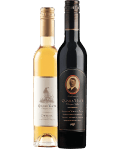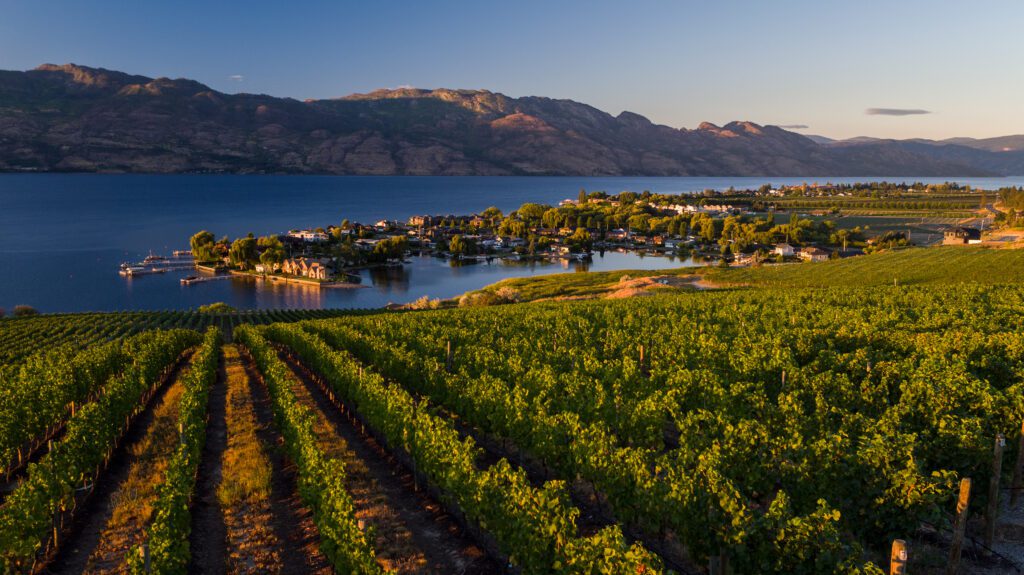By Tim Pawsey
Tim Pawsey (The Hired Belly) has been covering the wine & dining scene for 30 years thanks in part to the blossoming wine and dining culture of British Columbia.
To understand a little bit about the history of Chardonnay in the Okanagan Valley some time travel is in order. In the lead-up to the North American Free Trade Agreement (1988) vinifera grapes were still a relative rarity in the valley, if not the province at large. Many wines were still being made from hybrids, and the emphasis was still on volume of production rather than on quality. However, a handful of early pioneers had been convinced for quite a while that the future lay solely and solidly in vinifera.
As long-established growers, the Stewart family, was among the first to transition to vinifera, with early plantings of Chenin Blanc, Chasselas and Gewürztraminer, as well as Chardonnay. After supplying others for a couple of decades the family took the major step forward, opening their farmgate winery in 1989.
In an era when many were still trialling viable Germanic white varieties identified by the Becker Project, Quails’ Gate decided to concentrate its efforts on cool climate Chardonnay, as well as on Pinot Noir. Around this time, it’s worth noting that Pinot Blanc was BC’s most widely planted white grape and the biggest selling BC-grown white wine was a Gewürztraminer.
Old World Meets New
The Stewarts realized early on that the path to quality lay in a more nuanced style. With one foot in the old world and one in the new, Quails’ Gate sought out winemakers with experience from regions such as Oregon’s Willamette Valley and Central Otago, in New Zealand. This thoughtful genesis of a program very much inclined towards cool climate varieties laid a solid foundation for today’s distinctive house style.
While in the warmer, south Okanagan the attention was increasingly on Bordeaux varieties, the family realized their more temperate vineyards below Mount Boucherie were ideally suited to mirror Burgundy, albeit with a distinct Okanagan personality.
It wasn’t long before Quails’ Gate Estate Chardonnay became not only a staple for the winery but an Okanagan stalwart. This encouraged the family to embark on their acclaimed Stewart Family Reserve tier Chardonnay and Pinot Noir. In fact, convinced that well-made Okanagan wines could indeed hold their own beside comparable old-world wines, Ben Stewart was one of the first Okanagan winery owners to stage a blind comparative tasting of international benchmark wines, which very much proved his point.
Location. Location. Location.
Quails’ Gate is ideally situated in a cool climate area, at the foot of Mount Boucherie. Most importantly, “Our microclimate is moderated by our proximity to the lake,” explains Senior Winemaker, Jeff Del Nin. “Our vineyards run north-south, and they’re tilted to the south, getting lots of time in the sun. So that’s the primary orientation of the property. Because we’re far north the macroclimate is cool. But then we have warmer pockets, which allows us to get to full ripeness but with moderated temperatures,” says Jeff.
How does that translate into the wine? What it means is “In the wines you get full flavour ripeness—but also with a really nice, piercing backbone of acidity—which keeps the wine very fresh,” he says and adds “I’m very much sold on the Chardonnays coming off this terroir. I think they’re phenomenal!”
“They’re very rich. They have depth, a really fat mouthfeel to them, with richness and concentration. But they also have that spine of acidity—which you don’t see in the south Okanagan, for example—that goes down the middle.”
Jeff says it’s an exciting, vibrant type of wine, from a very beneficial location in which to be growing Chardonnay. “All the checkmarks are in place for top quality. You want to be northern to keep the overall climate cool—you don’t want to have overripe fruit; and then you have the proper row orientation, north to south, tilted to the south. It gets a very long time in the sun but is also cooled by the lake. It’s pretty breezy. But it has everything going for it.”
A complex and varied geology
Soils, naturally, are also a big part of the quality equation. Quails’ Gate sits below Mount Boucherie, the 50-million-year-old remains of an extinct stratovolcano, which yields a variety of different soil types. The good news about volcanic soils, says Jeff, is that they hold water—but not for too long. For that reason, vigour is never a problem. “Because it’s free draining it’s easier to control and have the vine do what you want it to do when you want it. You have that precision and control, unlike in some places where they don’t even water because there’s already so much water holding capacity.”
“Most of Quails’ Gate’s Chardonnay and Pinot Noir is grown on the higher slopes. There the soils are lighter than on lower Boucherie, more volcanic and contain less clay”, Jeff explains.
Associate Winemaker, Kailee Frasch agrees that the site is “unique for this side of the lake, with a beautiful mix of soils from glacial silt clay to sand and gravel. There are a lot of different characteristics depending on where you pick,” she says. “The gravel gives more minerality and freshness, while the clay gives more body and weight. But overall, the lake proximity means there’s a moderating effect, in addition to long growing days and cooler nights—it truly is a unique site.”
The shift to sophisticated oak
Over the years there’s been a tendency throughout the industry to soften the use of oak in reserve wines. At Quails’ Gate “We pulled it back a little bit,” says Frasch. “It varies as to how ripe the fruit is. We look for barrels to match the ripeness.” Also, she adds, it’s important to taste throughout the winemaking process from fermentation on. For instance, “You don’t want to match a delicate block of fruit with a powerful barrel. Ideally, you get the right combination of perfect balance and cohesiveness.”
“The main purpose of oak should be to complement not overpower the wine”, says Frasch, who also says, “Everyone thinks they don’t like oak, but it depends on the type of oak. There’s definitely a spot for oak to have a nice framing effect.” One of her favourites? “Rosemary’s Block Chardonnay is truly stylish, it’s super elegant without being too reserved; lots of fruit, aromatics and floral with a tiny hint of oak.”
At the vanguard of BC cuisine
Chardonnay has been a fixture in Quails’ Gate’s wine portfolio since the beginning, and with good reason. It makes for a seriously good food wine, something that became more apparent when the rise of BC wines spurred interest in local cuisine. In truth, aside from First Nations dishes, there was no such thing as regional cuisine before the emergence of the modern-day BC wine industry. Diners were more than familiar with all things European, such as French, Italian and Greek. But few could identify what constituted ‘Canadian’ cuisine, let alone ‘BC cuisine’, which was generally lumped in with California and labelled ‘West Coast.’
As more Okanagan wines made their way onto local wine lists a small cadre of winemakers started making visits to Vancouver to host winemaker dinners. Even then, in those early days, the idea of pairing food and wine was still foreign to many. But it was the emergence of the wine industry that helped place more emphasis on all things regional, validating and bringing impetus to local producers of every kind.
Old Vines Restaurant is a convincing showcase for the winery’s cool climate Chardonnays, paired with award-winning chef creations. The Estate Chardonnay 2020 is the perfect foil for a rich confit of duck and foie gras, with cherries, tarragon and duck fat popcorn, while the moderately oaked Stewart Family Reserve Chardonnay 2019 complements the creaminess and citrus notes of Dungeness crab with lemon mayonnaise, mint and cucumber.
Experience the exquisite flavours yourself by booking a table at Old Vines Restaurant, visiting the Quails’ Gate Wine Shop for a premium tasting or shop Quails’ Gate wines online.






